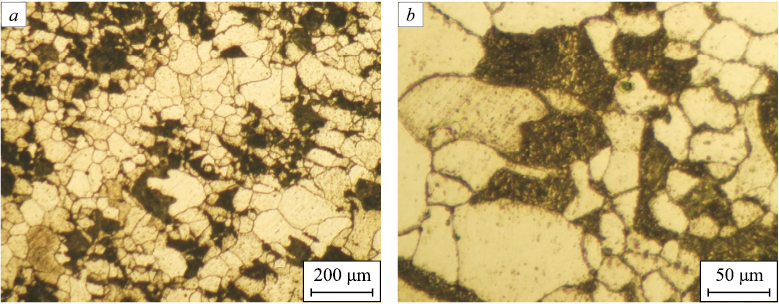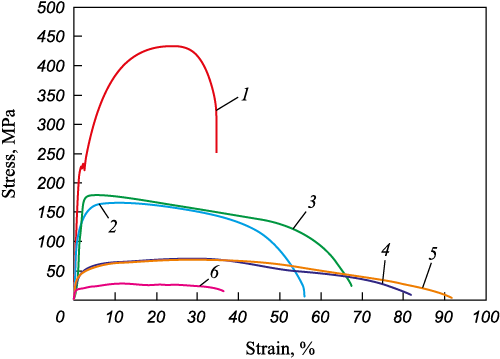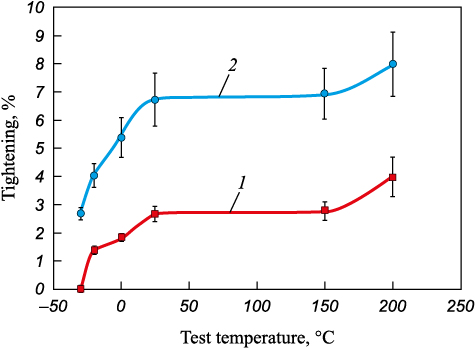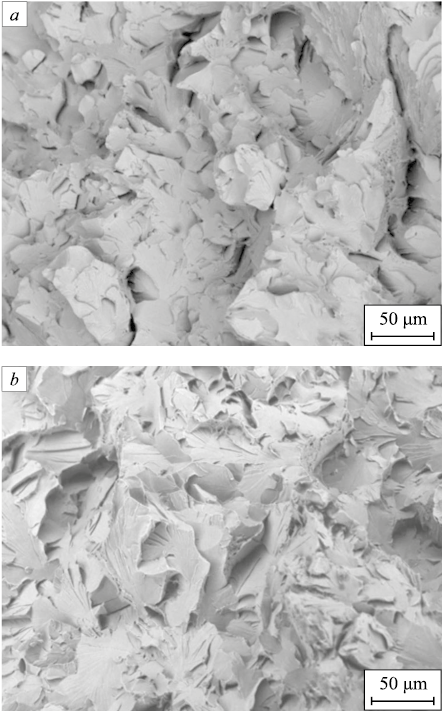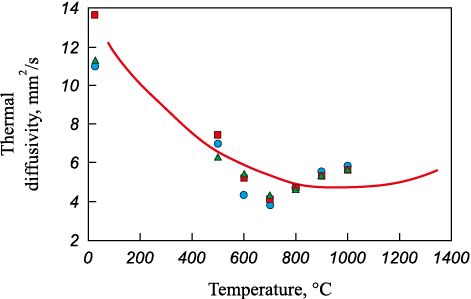Scroll to:
Structure and properties of steels for manufacture of core catcher vessel of nuclear reactor
https://doi.org/10.17073/0368-0797-2023-3-356-366
Abstract
The Russian new nuclear reactors are provided with a special core catcher vessel device (cc-vessel) designed to minimize the consequences of a severe beyond design basis accident at a nuclear power plant, when the reactor pressure vessel collapses and the core melts. For manufacture of the cc-vessel structural elements, low-carbon unalloyed or low-alloyed steels are used. When a severe beyond design basis accident develops, the cc-vessel’s body is subjected to extreme temperature and force loads, which can lead to degradation of the structure, loss of strength and failure of the entire cc-vessel. To calculate the strength characteristics of the cc-vessel, which ensure its safe and reliable operation, the detailed data are required on the structure and mechanical properties of low-carbon steels at high temperatures and after extreme thermal actions simulating the development of a severe beyond design basis accident. The paper analyzes data on the structure and mechanical properties (tensile strength, crack resistance, toughness and cyclic strength) of a number of low-carbon steels under extreme temperature and force actions, including conditions simulating the development of a severe beyond design basis accident at a nuclear power plant, in order to select the material for the design of cc-vessel of nuclear reactor. New data on the structure, mechanical properties, and thermal diffusivity in a wide temperature range of a Cr – Mo steel (Russian Standard – 15KhM) as a candidate structural material for the manufacture of the cc-vessel body are presented. The low content of manganese and alloying with molybdenum and vanadium in 15KhM steel provides a finer grained structure and eliminates the steel’s tendency to temper brittleness.
Keywords
For citations:
Nikulin S.A., Rogachev S.O., Belov V.A., Shplis N.V., Komissarov A.A., Turilina V.Yu., Nikolaev Yu.A. Structure and properties of steels for manufacture of core catcher vessel of nuclear reactor. Izvestiya. Ferrous Metallurgy. 2023;66(3):356-366. https://doi.org/10.17073/0368-0797-2023-3-356-366
Introduction
In order to minimize consequences of beyond the design accident (BDB) at NPS, involving destruction of reactor vessel, Russian new generation WWER reactors are equipped with special core catcher vessels (cc-vessel) [1; 2]. This device is a large structure with diameters up to 6 m and the height up to 12 m, and a vessel thickness of up to 60 mm. Low carbon non-alloy and low alloy steels are used for manufacture of cc-vessel structural elements [3]. At present only Russian NPS with new generation reactors are equipped with a cc-vessel. Their structural elements, vessel and support plate, are manufactured from 22K and 09G2S steels, respectively.
In the course of BDB, the cc-vessel is exposed simultaneously to long-term thermal impact, as well as high static and impact loads [4 – 6]. The temperature of corium entering cc-vessel during BDB exceeds several thousand degrees. According to calculations the cc-vessel during localization and cooling of molten corium is heated to 1200°C. Corium cooling takes up to 10 – 12 months [7]. Long term thermal impact can significantly change the structural state and, as a consequence, induce degradation of the mechanical properties of the vessel material. This leads to strength loss and increase in destruction of cc-vessel [8; 9]. Calculations of the strength properties of the cc-vessel, providing for its safe and reliable operation, require for detailed data on the structure and mechanical properties of low carbon steels at high temperatures and after extreme thermal impacts. It is important to account for the possible heterogeneity of the structure and mechanical properties of the material [10]. For the reliable operation of the cc-vessel, it is also important to retain high impact strength and resistance against the low cycle fatigue of vessel material after corium cooling, mostly for NPS in areas with higher seismic hazard.
The issue of selecting the optimum material for the manufacture of cc-vessel structural elements, capable of providing the required level of strength and impact strength under BDB conditions, has not been discussed. This is partially due to insufficient data on the mechanical properties and resistance against destruction of low carbon steels under extreme temperature and load conditions.
In the past decade, studies have been carried out aimed at detailed analysis of changes in structure and mechanical properties of low carbon steels under extreme temperature and load conditions, including those simulating BDB [11 –22]. In particular, the changes in structural state were studied. The mechanical properties were established, and the mechanical behavior of 22K and 09G2S steels was analyzed at the temperatures from ambient to 1200°C. Resistance against destruction before and after extreme impact peculiar for BDB [11; 12] was also analyzed. Embrittlement was studied upon temperature impacts in the range of temper brittleness of 22K and 09G2S steels under BDB conditions [14 – 16]. The influence of thermal impact on low cycle fatigue of 22K steel was determined [17]. The advantages and disadvantages of 22K and 09G2S steels are described for their use in the cc-vessel. It was demonstrated that 22K and 09G2S steels are characterized by the following disadvantages: a tendency to increase in austenite grain and decrease in strength at high temperatures due to relatively high manganese content; absence of carbide forming elements in the steels, as well as tendence to temper brittleness in certain temperature range and occurrence of brittle intergranular failure (for 22K steel). In order to eliminate the existing uncertainties in the cc-vessel and to improve competitiveness of Russian NPS at global market new material for cc-vessels based on modification of the alloying system needs to be selected. Studies of its high temperature properties under BDB conditions also need to be carried out.
This work analyzes previously available and new data on the structure and mechanical properties of some low carbon steels under conditions simulating BDB at NPS, aimed at selecting optimum material of cc-vessel for nuclear reactors.
Structure and mechanical properties of 22K, 09G2S and SA533-B1 low carbon steels under conditions simulating beyond the design basis accident
Low carbon steels, such as 22K and 09G2S (foreign analogs: 20Mn5 in Germany or AISI 1022 in USA and 13Mn6 in Germany, respectively) are usually applied as structural materials for items operating at moderate mechanical loads and temperatures not higher than 350–450 °C. This is related with a significant decrease in their strength properties (especially yield stress) upon heating to higher temperatures [23 – 25]. An important advantage of low carbon steels is their weldability and high thermal diffusivity [26 – 28]. Little research has been done on the high-temperature mechanical properties of such steels. Published results are as yet unavailable. As of the present moment, the behavior of low carbon steels under BDB conditions were not carried out. Only few foreign studies of high temperature properties are available (including creeping) of low carbon steel with the addition of molybdenum and nickel SA533-B1 [18; 19] to be used in cc-vessel [3]. Table 1 presents the chemical composition of SA533-B1 steel in comparison with 22K and 09G2S steels. The work [18] presents only ultimate strength of SA533-B1 steel as a function of temperature, determined in tensile tests (according to ASTM). According to this data, sharp drop of ultimate strength from 380 to 150 MPa occurs in the temperature range from 527 to 727 °C (Fig. 1). In addition, interest is attracted to data on thermal diffusivity of SA533-B1 steel. The thermal diffusivity of SA533-B1 steel in the range from 77 to 907 °C decreases from 12.1 to 4.7 mm2/s, and with temperature increase to 1340 °C, it increases to 5.5 mm2/s [18].
Table 1. Chemical composition of low-carbon steels, wt. %
Fig. 1. Temperature dependence of tensile strength of SA533-B1 steel [18]: |
Other experimental results of the high temperature mechanical properties of SA533-B1 steel were limited by analysis of the influence of strain rate (0.050–0.007 min\(^-\)1) on the strength and plasticity in the temperature range from 650 to 1200 °C [18].
Numerous recent works devoted to studies of the behavior of low carbon steels under extreme temperature and load conditions have been carried out for 22K and 09G2S steels [11 – 17; 30]. Three modes of thermal impact simulating BDB conditions were used in these works [7].
Mode 1: heating to 1000 °C at the rate of 225 °C/h; cooling to 900 °C at the rate of 6 °C/h; cooling to 840 °C at the rate of 1 °C/h; holding at 840 °C in 39.2 h; cooling to 750 °C at the rate of 2 °C/h; cooling to 700 °C at the rate of 2 °C/h; cooling in furnace to ambient temperature.
Mode 2: heating to 650 °C at the rate of 200 °C/h; cooling to 480 °C at the rate of 1 °C/h; cooling in furnace to ambient temperature.
Mode 3: heating to 1200 °C at the rate of 225 °C/h; holding in 3.7 h; cooling in furnace to ambient temperature.
The following main procedures were applied by the authors to establish the mechanical properties of steels.
• Tensile tests in the temperature range from 23 to 1050 °C were pursuant to State standards GOST 1497–84 and GOST 9651–84 using a Zwick/Roell machine, and at 1200°C in the chamber of Gleeble 3800 testing machine. The temperature maintenance accuracy was ±5 °C and ±1 °C, respectively, and the deformation rate: 0.004 s\(^-\)1. The tests were performed in a vacuum. Three samples in each state were tested.
• Impact bending tests of samples with the size of 10×10×55 mm with V-notch were carried out at temperatures ranging from 200 to –50 °C using an Instron SI-1M impact tester with maximum impact work of 300 J at the pendulum speed upon impact equaling to 5 ± 0.5 m/s. The samples were heated to the test temperature in an electric furnace, and cooled in a LAUDA Proline RP890 climatic chamber. 18 samples were tested, in order to plot each serial curve.
• Static crack resistance tests of rectangular samples with notch were carried out at ambient temperature according to three-point bending using an Instron 5569 machine. The parameter of non-linear fracture mechanics was used as the property of crack resistance: critical J-integral (JC). This in the physical sense is the energy in the region of crack apex normalized per unit displacement of crack dl. The J-integral was determined using the experimental Begley–Landes method [31].
The strength properties of 22K (in normalized state) and 09G2S (after quenching and tempering) steels were determined in the range of test temperatures from 23 to 1200 °C [11; 12]. It was demonstrated that the most significant decrease of strength of 22K steel is observed in the range of 400 – 650 °C, and of 09G2S steel in the range of 600–750 °C. Upon a further decrease in the temperature, the unstrengthening rate decreases. At 1200 °C, the yield stress and ultimate strength of both steels are the same equaling to 12 and 21–22 MPa, respectively. The strain curves of 22K and 09G2S steels at the temperatures above 600 and 800 °C, respectively, have a wavelike nature. This can be attributed to strengthening–unstrengthening due to dynamic recrystallization. Thermal impact according to mode 1 decreases the yield stress of 22K steel by 7 – 22 % in the range of tests temperatures from 23 to 300 °C. This also increases the yield stress and ultimate strength by 12 –50 and 10 – 32 %, respectively, in the temperature range from 400 to 700 °C. At higher temperatures, the effect of thermal impact on 22K steel is less pronounced in the form of moderate decrease in yield stress.
Metallographic studies have demonstrated that in both steels, 22K and 09G2S, in the case of a temperature dwell time above 1000°C, intensive grain growth is observed. Grain size non-homogeneity becomes more pronounced. It was demonstrated that 09G2S steel is more prone to grain growth upon heating to such high temperature than 22K steel [11; 12].
22K steel in initial state is characterized by a high resistance against low cycle bending fatigue: limited fatigue endurance at lifetime of N = 3.5·104 cycles was 360 MPa [17]. Thermal impact according to modes 2 or 3 leads to insignificant decrease in the resistance to low cycle fatigue: limited fatigue endurance decreases by 9 %.
Static crack resistance tests demonstrated that in the initial state, the parameter JC equals to 118 ± 8 kJ/m2, Thermal impact according to modes 1 and 2 decreases JC by 23 and 30 %, respectively, in comparison with the initial state [30].
The highest negative influence of thermal impact is on impact strength of 22K steel [14; 15]. Consecutive thermal impact according to modes 1 and 2 leads to an increase in the temperature of viscous brittle transition by ~100 °C (from 23 to 125 °C). The impact strength KCV decreases from 180 – 208 to 150 J/cm2 already at the test temperature of 75 °C, and the fractures contain about 40 % of brittle constituent. On the contrary, for 09G2S steel even long-term overheating according to mode 3 exerts weak influence of impact strength [16]. Viscous brittle transition in 09G2S steel both in initial state and after heating occurs in the region of low temperatures (–40 and –30 °C, respectively) at an impact strength of 285–300 J/cm2, which is several times higher than for 22K steel.
Experimental
Low carbon low alloyed 15KhM steel can be considered as an alternative to 22K and 09G2S steels. Alloying with carbide forming elements (Mo and V) and lower manganese content suppress the tendency of the steel to grain growth and temper brittleness.
10 kg ingots were exposed to hot rolling with a reduction rate of 25% and subsequent air cooling from the rolling temperature. The chemical composition of steel determined by optical emission method is summarized in Table 2.
Table 2. Chemical composition of 15KhM steel, wt. %
|
The modes of thermal impact simulating BDB conditions were the same as in [11 – 17; 30] (see previous section).
The tension tests were carried out according to previously described procedure [11; 12].
The impact bending tests were carried out according to the procedure described in [14 – 16]. The macrogeometry of fractures after tests was determined according to [32].
The metallographic analysis was carried out using a NIM-100 microscope at magnifications of 100 – 500×. In order to reveal grain structure, 5% aqueous solution of nitric acid was used. In order to identify former austenitic grain, a warm solution of picritic acid was used.
Thermal diffusivity was measured by laser flash using a NETZSCH LFA 457 MicroFlash (Germany). The instrument is equipped with IR sensor on the basis of InSb. The following instrument settings were used:
– laser voltage varied in the range of 1730 – 2114 V;
– threshold stability of basic line: 1.0 V/10 s.
The measurements are comprised of two stages:
–recording of the temperature increase of the rear side of a plane-parallel sample as a function of time after irradiation of its front side by short pulse of infrared laser radiation 1.064 μm using a precision infrared sensor;
– calculation of thermal diffusivity using the selected mathematical model.
The measurements were carried out in argon 6.0, at a purge rate of 60 ml/min. The samples were coated with thin graphite layer («GRAPHITE 33» spray, Kontakt Chemie). The thermal diffusivity was calculated using mathematical model “Cape-Lehmann + pulse correction”. This model takes into account frontal and radial heat losses and is usually suitable for most materials.
Results and discussion
In initial state, 15KhM had hypopearlitic structure with the recrystallization degree of about 85 % (Fig. 2). Predominant ferrite and pearlite grain size was 15 – 25 μm. This is slightly lower than in 22K steel [17]. After thermal impact according to mode 1 the austenite grain grows by 55 %: from 23.5 ± 9.1 μm to 36.5 ± 14.9 μm (Fig. 3). The hypopearlitic structure is enlarged and grain size nonhomogeneity becomes more pronounced (Fig. 4). After thermal impact according to mode 2, the predominant grain size of hypopearlitic structure is the same, and the recrystallization degree increases to 99 % (Fig. 5).
Fig. 2. Microstructure (а) and ferrite (b) and pearlite (c) grain distribution histograms
Fig. 3. Microstructure and former austenite grain distribution histograms for 15KhM steel
Fig. 4. Microstructure of 15KhM steel after thermal exposure according to mode 1
Fig. 5. Microstructure (а) and ferrite (b) and pearlite (c) grain distribution histograms |
The mechanical properties of 15KhM steel are summarized in Table 3, and the stress–strain curves in Fig. 6. In the temperature range of 700 – 900 °C, the yield stress σ0.2 in initial state changes in average from 161 to 37 MPa, and the ultimate strength σu from 180 to 70 MPa. Thermal impact according to mode 1 results in a decrease in the yield stress by 27 %, and the ultimate strength by 7 % at the test temperature of 700 °C without significant statistical influence on the strength at 900 °C. After the thermal impact according to mode 1, the yield stress and ultimate strength at 23 °C equaled in average 222 and 436 MPa, and at 1200 °C, 15 and 25 MPa, respectively.
Table 3. Mechanical properties of 15KhM steel before
Fig. 6. Stress-strain curves of 15KhM steel at different temperatures | |||||||||||||||||||||||||||||||||||||||
Therefore, at 700 °C the strength of 15KhM steel in initial state is 2 – 4 times higher in comparison with 22K steel [13]. After thermal impact, the strength of 15KhM steel at all considered temperatures in the range from 23 to 1200 °C is higher when compared to 22K steel. In addition, at 700°C the strength of 15KhM steel in initial state is by 1.5 times higher when compared to 09G2S steel and is comparable with that of SA533-B1 steel. At 900 °C the strength of 15KhM steel in initial state is comparable to that of SA533-B1 steel, and higher in comparison to 09G2S steel.
According to the results of impact bending test (Table 4, Fig. 7), in the fractures of steel in initial state, the brittle constituent (X) to an amount of 30 – 90 % occurs at ambient temperature. At the temperatures from 60 to 0 °C, the impact strength KCV drops sharply from 171 to 43 J/cm2. During a further temperature increase to minus 20 °C, the impact strength consistently decreases to 20 J/cm2.
Table 4. Results of impact bending tests of 15KhM steel
Fig. 7. Impact strength curves of 15KhM steel samples (a) | |||||||||||||||||||||||||||||||||||||||||||||||||||||||||
After thermal impact according to mode 2, the brittle constituent in the fracture surface in amount of 30% occurs at 0 °C. The impact strength does not decrease significantly remaining at the level of 216 J/cm2. Total brittle fracture is observed at 0 °C for steel in initial state, and after thermal impact at –50 °C. Therefore, as a consequence of thermal impact, the starting temperature of viscous brittle transition of 15KhM steel decreases by 20 – 30 °C. The range of viscous brittle transition is expanded by 25 °C. Increase in the properties of impact strength is related to an increase in the degree of structure recrystallization as well as decrease in residual stresses after hot rolling as a consequence of thermal impact.
According to the measurements of geometry of samples from 15KhM steel after impact tests, it was determined that the samples after thermal impact according to mode 2 were destroyed in a more viscous pattern. They also demonstrated a higher tightening than the samples in initial state in overall range of test temperature (Fig. 8).
Fig. 8. Dependence of reduction of 15KhM steel samples on the impact test temperature: |
The fracture surface of impact samples at temperatures below the start of viscous brittle transition in the region under notch is presented by cleavage facets with river line. The facet size is 10 – 80 μm, and the fracture relief is characterized by a highly non-uniform height of individual elements (Fig. 9).
Fig. 9. Fracture surfaces of impact samples at room temperature in initial state (a) |
Thus, the impact strength of 15KhM steel in initial state is inferior to that of 22K and 09G2S steels. However, after thermal impact according to mode 2, the impact strength of 15KhM steel increases and is comparable with that of 22K steel.
The thermal diffusivity of 15KhM steel as a function of temperature in comparison with 22K and 09G2S steels is illustrated in Fig. 10. In addition, the data for SA533-B1 steel are also presented [18]. As can be seen in the plot, the thermal diffusivity for 22K, 09G2S and 15KhM steels as a function of temperature, is characterized by inflection at the temperature above 700 °C. This is related to α → γ transformation occurring in steels at these temperatures. At ambient temperature, the thermal diffusivity of 15KhM and 09G2S steels is the equal to 11.0 – 11.2 mm2/s, while that of 22K is slightly higher: 13.7 mm2/s. At 500 °C the lowest thermal diffusivity is demonstrated by 15KhM steel: 6.3 mm2/s, while the highest by 22K steel: 7.4 mm2/s. At 600 °C lowest thermal diffusivity is demonstrated by 09G2S steel: 4.3 mm2/s, while the highest by 22K and 15KhM steels: 5.3 mm2/s. In the range from 700 to 100 °C the thermal diffusivity of steel slightly increases, while the temperature dependence of thermal diffusivity for all three steels in this range does not differ statistically. This data differs from that of SA533-B1 steel, for which the inflection in the curve was recorded at a higher temperature: 900 °C.
Fig. 10. Temperature dependence of thermal diffusivity of low-carbon steels: |
Conclusions
It was demonstrated that low carbon low alloy 15KhM steel is an alternative material to 22K and 09G2S steels as structural material for cc-vessels in nuclear reactors. This steel is characterized by a relatively high level of thermal diffusivity and good weldability. Alloying with molybdenum and vanadium, as well as low manganese content, provides finer grain structure in comparison with 22K and 09G2S steels and eliminates tendency to temper brittleness. This has a positive influence on strength and impact strength of cc-vessel in overall temperature range in the event of BDB. Integrated studies under BDB simulating conditions are required for the experimental establishment of an overall set of physicochemical properties of 15KhM steel and its application as a material of cc-vessel.
References
1. Artamonov N.V., Sidorov A.S. Nuclear safety of melt localisator device for NPP with WWER reactor model. Izvestia vuzov. Yadernaya energetica. 2012;(3):23–31. (In Russ.).
2. Sidorov A.S. Core catcher vessel for nuclear power plants with VVER-1000 reactors. In: 7th Int. Sci. and Tech. Conf. “Ensuring the Safety of Nuclear Power Plants with VVER”. Podolsk: OKB Gidropress: 2011. (In Russ.).
3. Rempe J.L., Knudson D.L., Condie K.G., Suh K.Y., Cheung F.-B., Kim S.-B. Conceptual design of an in-vessel core catcher. Nuclear Engineering and Design. 2004;230(1–3): 311–325. https://doi.org/10.1016/j.nucengdes.2003.11.030
4. Sultan T., Sapra M.K., Kundu S., Kadam A.V., Kulkarni P.P., Rao A.R. Experimental & analytical study of passive thermal sensing system developed for cooling water injection into AHWR core catcher. Nuclear Engineering and Design. 2017;322:81–91. https://doi.org/10.1016/j.nucengdes.2017.06.021
5. Rempe J.L., Knudson D.L., Condie K.G., Suh K.Y., Cheung F.-B., Kim S.-B. Corium retention for high power reactors by an in-vessel core catcher in combination with external reactor vessel cooling. Nuclear Engineering and Design. 2004;230(1–3):293–309. https://doi.org/10.1016/j.nucengdes.2003.11.031
6. Fischer M. The severe accident mitigation concept and the design measures for core melt retention of the European Pressurized Reactor (EPR). Nuclear Engineering and Design. 2004;230(1–3):169–180. https://doi.org/10.1016/j.nucengdes.2003.11.034
7. Development of a program of heat treatment and mechanical testing for experimental assessment of degradation degree of the welded joints mechanical properties in material of cc-vessel casing and guide plate. Report of the National Research Center “Kurchatov Institute”, RPR.0131.10UJA.JKM.BN.DD0001, No. 110.10-49/1-138-118, 2018. (In Russ.).
8. Odesskii P.D., Egorova A.A. Strength of steel for unique engineering structures. Russian Metallurgy (Metally). 2012;2012(10):911–918. https://doi.org/10.1134/S0036029512100151
9. Odesskii P.D., Vedyakov I.I. Steel in Building Metal Structures. Moscow: Metallurgizdat; 2018:906. (In Russ.).
10. Kudrya A.V., Sokolovskaya E.A., Trachenko V.A., Ning Le Hai, Skorodumov S.V., Papina K.B. Measurement of nonuniformity of fracture in structural steels with heterogeneous structure. Metal Science and Heat Treatment. 2015;57(3–4): 190–196. https://doi.org/10.1007/s11041-015-9860-z
11. Nikulin S.A., Rogachev S.O., Nikolaev Yu.A., Vasiliev S.G., Belov V.A., Turilina V.Yu. High-temperature mechanical properties of low-carbon steel used for the manufacture of core catcher vessel. Progress in Nuclear Energy. 2021;142:104015. https://doi.org/10.1016/j.pnucene.2021.104015
12. Nikulin S.A., Rogachev S.O., Vasil’ev S.G., Belov V.A., Nikolaev Yu.A. Effect of high temperatures on the mechanical properties of 09G2S steel. Russian Metallurgy (Metally). 2021;2021(4):160–163. https://doi.org/10.1134/S003602952104025X
13. Nikulin S.A., Rogachev S.O., Belov V.A., Turilina V.Yu., Shplis N.V. Effect of high temperatures on the mechanical properties of the weld metal in the welded joint of low-carbon low-alloy steel. Russian Metallurgy (Metally). 2021;2021(10):1314–1319. https://doi.org/10.1134/S0036029521100256
14. Nikulin S.A., Rogachev S.O., Vasil’ev S.G., Belov V.A., Komissarov A.A. Effect of long-term annealing on the impact toughness of 22K steel. Russian Metallurgy (Metally). 2021;2021(4):149–153. https://doi.org/10.1134/S0036029521040248
15. Nikulin S.A., Rogachev S.O., Belov V.A., Komissarov A.A., Turilina V.Yu., Shplis N.V., Nikolaev Yu.A. Influence of long-term high-temperature action on impact toughness of base metal and weld metal of 22K steel welded joint. Izvestiya. Ferrous Metallurgy. 2021;64(7):498–509. (In Russ.). https://doi.org/10.17073/0368-0797-2021-7-498-509
16. Nikulin S.A., Rogachev S.O., Belov V.A., Komissarov A.A., Turilina V.Yu., Shplis N.V., Nikolaev Yu.A. Impact strength of low-carbon steel 09G2S welded joint metal. Metallurgist. 2022;65(8):1391–1400. https://doi.org/10.1007/s11015-022-01286-2
17. Nikulin S.A., Rogachev S.O., Belov V.A., Zadorozhnyy M.Yu., Shplis N.V., Skripalenko M.M. Effect of prolonged thermal exposure on low-cycle bending fatigue resistance of low-carbon steel. Metals. 2022;12(2):281. https://doi.org/10.3390/met12020281
18. Rempe J.L., Knudson D.L. High temperature thermal and structural material properties for metals used in LWR vessels. In: Proceedings of ICAPP ’08, Anaheim, CA USA, 2008:8220.
19. Thinnes G.L., Korth G.E., Chavez S.A., Walker T.J. High-temperature creep and tensile data for pressure vessel steels SA533B1 and SA508-CL2. Nuclear Engineering and Design. 1994;148(1–3):343–350. https://doi.org/10.1016/0029-5493(94)90119-8
20. Loktionov V., Lyubashevskaya I., Sosnin O., Terentyev E. Short-term strength properties and features of high-temperature deformation of VVER reactor pressure vessel steel 15Kh2NMFA-A within the temperature range 20–1200 °C. Nuclear Engineering and Design. 2019;352:110188. https://doi.org/10.1016/j.nucengdes.2019.110188
21. Loktionov V.D., Sosnin O.V., Lyubashevskaya I.V. Strength properties and idiosyncrasies of the deformational behavior of 15Kh2NMFA-A steel at temperatures 20–1100°C. Atomic Energy. 2005;99(3):665–669. https://doi.org/10.1007/s10512-005-0263-x
22. Belomyttsev M.Yu., Mordashov S.V. Regularities of short-term creep of St3 steel. Izvestiya. Ferrous Metallurgy. 2015;58(11):798-802. (In Russ.). https://doi.org/10.17073/0368-0797-2015-11-798-802
23. Yang C.-C., Liu C.-L. Improvement of the mechanical properties of 1022 carbon steel coil by using the Taguchi method to optimize spheroidized annealing conditions. Materials. 2016;9(8):693. https://doi.org/10.3390/ma9080693
24. Zubchenko A.S. Grade Guide of Steels and Alloys. Moscow: Mashinostroenie; 2003:784. (In Russ.).
25. Budynas R.G., Nisbett J.K. Shigley’s Mechanical Engineering Design. 11th ed. New York: McGraw-Hill; 2019:1120.
26. Saraev Yu.N., Bezborodov V.P., Gladovskii S.V., Golikov N.I. Properties of the welded joints of manganese steel made by low-frequency pulsed arc welding. Russian Metallurgy (Metally). 2017;2017(4):287–292. https://doi.org/10.1134/S0036029517040206
27. Poletaev Yu.V., Poletaev V.Yu. One-pass arc welding under thin slag layer of thick 09G2S steel plate structures. Vestnik of Don State Technical University. 2018;18:50–58. (In Russ.) https://doi.org/10.23947/1992-5980-2018-18-1-50-58
28. Fetisov G.P., Karpman M.G., Matyunin V.M. Materials Science and Technology of Metals. Moscow: Oniks; 2009:624. (In Russ.).
29. Chen C.Y., Huang J.Y., Yeh J.J., Hwang J.R., Huang J.Y. Microstructural evaluation of fatigue damage in SA533-B1 and type 316L stainless steels. Journal of Materials Science. 2003;38(4):817–822. https://doi.org/10.1023/A:1021817216519
30. Nikulin S.A., Rogachev S.O., Belov V.A., Ozherelkov D.Yu.,
31. Shplis N.V., Fedorenko L.V., Molyarov A.V., Konovalova K.A. Fracture toughness of 22K-type low-carbon steel after extreme thermal exposure. Journal of Materials Engineering and Performance. 2023. https://doi.org/10.1007/s11665-022-07746-9
32. Begley J.A., Landes J.D. The J-integral as a fracture criterion. In: Fracture Toughness, Part II. ASTM STP 514, 1972:1–20.
33. Shtremel M.A. Informativeness of measurements of impact toughness. Metal Science and Heat Treatment. 2008;50(11): 11–12. https://doi.org/10.1007/s11041-009-9099-7
About the Authors
S. A. NikulinRussian Federation
Sergei A. Nikulin, Dr. Sci. (Eng.), Prof., Head of the Chair “Metallography and Physics of Strength”
4 Leninskii Ave., Moscow 119049, Russian Federation
S. O. Rogachev
Russian Federation
Stanislav O. Rogachev, Cand. Sci. (Eng.), Assist. Prof. of the Chair “Metallography and Physics of Strength”, National University of Science and Technology “MISIS”; Research Associate, Baikov Institute of Metallurgy and Materials Science, Russian Academy of Sciences
4 Leninskii Ave., Moscow 119049, Russian Federation
49 Leninskii Ave., Moscow 119991, Russian Federation
V. A. Belov
Russian Federation
Vladislav A. Belov, Cand. Sci. (Eng.), Assist. Prof. of the Chair “Metallography and Physics of Strength”
4 Leninskii Ave., Moscow 119049, Russian Federation
N. V. Shplis
Russian Federation
Nikolai V. Shplis, Engineer
4 Leninskii Ave., Moscow 119049, Russian Federation
A. A. Komissarov
Russian Federation
Aleksandr A. Komissarov, Cand. Sci. (Eng.), Assist. Prof., Head of the Laboratory “Hybrid Nanostructured Materials”
4 Leninskii Ave., Moscow 119049, Russian Federation
V. Yu. Turilina
Russian Federation
Veronika Yu. Turilina, Cand. Sci. (Eng.), Assist. Prof. of the Chair “Metallography and Physics of Strength”
4 Leninskii Ave., Moscow 119049, Russian Federation
Yu. A. Nikolaev
Russian Federation
Yurii A. Nikolaev, Dr. Sci. (Eng.), Prof., Leading Researcher
1 Akademika Kurchatova Sqr., Moscow 123182, Russian Federation
Review
For citations:
Nikulin S.A., Rogachev S.O., Belov V.A., Shplis N.V., Komissarov A.A., Turilina V.Yu., Nikolaev Yu.A. Structure and properties of steels for manufacture of core catcher vessel of nuclear reactor. Izvestiya. Ferrous Metallurgy. 2023;66(3):356-366. https://doi.org/10.17073/0368-0797-2023-3-356-366






